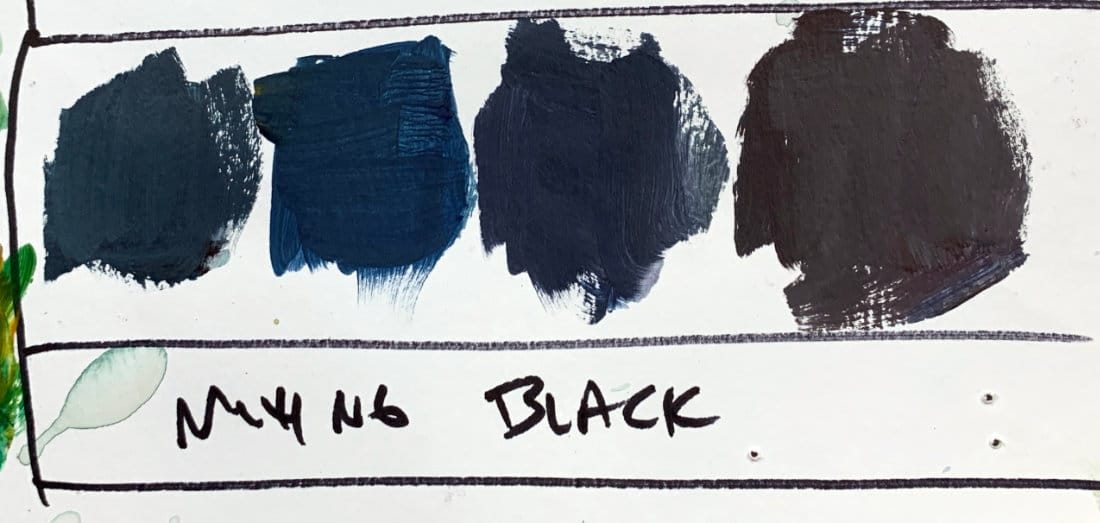Mixing Black and Gray in Acrylic Painting
Learn to mix black and gray from scratch using complementary colors. Discover how warm and cool shifts bring life to neutral tones in acrylic painting.

Store-bought black can feel lifeless. Mixing your own not only gives you more control, but it also creates richer, more natural grays that better fit your painting’s mood and lighting. In this lesson, I show how to mix beautiful, deep blacks and nuanced grays using a limited palette of transparent and opaque pigments.
This lesson is part of the Acrylic Landscape Painting Fundamentals Course.
Why Mix Your Own Black?
Pre-mixed tube blacks often flatten a painting because they contain no temperature variation. When you mix your own, you can shift the color slightly warmer or cooler, depending on the scene. This subtle bias adds life to shadows and depth to neutral passages.

The Basic Recipe
Start with:
- Phthalo Green
- Ultramarine Blue
- Transparent Red Oxide
- Alizarin Crimson
Mixing these together creates a rich, dark black. Add white to reveal its bias — if it leans blue, it’s cool; if it leans red or brown, it’s warm.
Adjusting the Temperature
- Cooler Black: Add more Ultramarine Blue.
- Warmer Black: Add more Transparent Red Oxide or Crimson.
You’ll see the differences most clearly by lightening each mixture with a touch of white — that’s how you can “read” your black’s temperature.
Creating Beautiful Grays
Once you understand the temperature of your black, you can mix in various amounts of white to create natural grays. These subtle tones are perfect for skies, rocks, roads, tree trunks, or overcast lighting conditions in landscapes.
The key is to observe the bias: does your gray lean toward blue, violet, or brown? That’s where the life of your painting lives.
Key Takeaways
- Mix black using complementary colors like red + green or blue + brown.
- Add white to test if your black leans warm or cool.
- Warm blacks are great for sunlit areas; cool blacks work well in shadow.
- Mixed blacks produce richer, more natural grays than store-bought tubes.
Course Navigation
Previous Lesson: Color Mixing 101 – Strategic Color Control
Next Lesson: Mixing Greens in Acrylic Painting
Acrylic Landscape Hub - view all modules and lessons
Learn & Improve Your Acrylic Skills
- Acrylic Hub– Your go-to guide for tutorials, tips, and resources.
- Ultimate Beginner Acrylic Course - Start painting with confidence.
- Subscribe for More Great Content - Get tutorials, tips, and updates straight to your inbox.
- Follow Me on Pinterest - Daily inspiration, tips, and fresh ideas.
Recommended Acrylic Painting Materials
-
Princeton Catalyst Brushes – Flats (#6, #12), Rounds (#4, #8), Fan (#4), Liner Brush
Durable synthetic bristles for versatile acrylic techniques -
Liquitex Heavy Body Acrylic Paint – Essential Colors
Cadmium Yellow, Yellow Ochre, Alizarin Crimson, Cadmium Red Light, Ultramarine Blue, Cobalt Blue, Burnt Sienna, Titanium White -
Winsor & Newton Cotton Canvas
Reliable stretched canvas for studio and plein air work -
Strathmore 400 Series Mixed Media Paper
Heavyweight, acid-free paper for acrylic and mixed media -
Fabriano Artistico 140lb Cold Press Paper
Excellent for acrylic, mixed media, and textured effects -
Blick Multi-Colored Painting Knife Set
Variety of shapes for texture, scraping, and bold strokes - Miscellaneous: Two pint-sized water containers, paper towels (from Home Depot or Walmart)
- Note: I use canvas or sturdy cardboard as my palette — no store-bought palettes needed.




